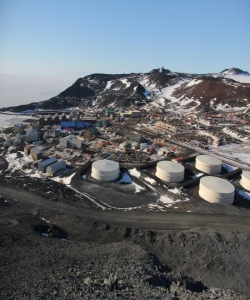Update
Deployment Delayed: Juan was unable to join the team due to medical issue. Diario en Español: ¡Puede leer la bitácora de expedición en Español! Para acceder la versión en español de cada entrada en la bitácora de la expedición, haga click en la pestaña "Journal Tab" en la parte superior de ésta página. Después, seleccione la entrada en la bitácora que desee leer haciendo click en la pestaña "Read Full Journal Entry" al lado de cada foto. Una vez que haya entrado a la versión en Inglés, haga click en la pestaña "Translation" para llegar a la versión en español.
What Are They Doing?
 2014 team members Paul and Sam removing neutron monitor tubes. Photo from UWRF Blog
2014 team members Paul and Sam removing neutron monitor tubes. Photo from UWRF Blog
We will be performing maintenance on the neutron monitors. The neutron monitors are used to study the sun, which occasionally undergoes solar storms that produce bursts of energetic particles. We are interested in learning more about the energy range and abundance of the particles produced in these events, which is important for understanding how to protect electronics and the electrical grid from extreme space weather events.
¿Qué están haciendo?
CosRay: Monitoreo de Neutrones
Nuestro trabajo consistirá en dar mantenimiento a los monitores de neutrones. Estos sensores son utilizados para estudiar al sol, el cual produce ocasionalmente tormentas solares en las que emite partículas de gran energía. Nos interesa aprender más sobre el rango energético de éstas partículas, asi como sobre su abundancia, ya que esto nos permitirá predecir mejor las tormentas solares y así podr proteger equipos electrónicos y las redes eléctricas acá en la tierra.
Where Are They?
 A view of McMurdo Station from Ob Hill. McMurdo Station, Antarctica.
A view of McMurdo Station from Ob Hill. McMurdo Station, Antarctica.
We will be staying at McMurdo station, and working at the CosRay building, which is a short hike from the station, just beyond Observation Hill. The neutron monitor project is the longest continuously running experiment in Antarctica.
¿En dónde están?
Nos hospedaremos en la estación McMurdo y trabajaremos en el edificio CosRay, a corta distancia de la estación, un poco más allá del Observation Hill. El proyecto de detección de neutrones es el experimento de monitoreo continuo más longevo en la Antártida.
Latest Journals

Dr. Madsen is the chair of the Physics Department at UW-River Falls and Associate Director of the IceCube Neutrino Observatory where he directs the education and outreach program. His research interests include heliophysics and astrophysics, which he has studied at his various projects in Antarctica. In addition to research, Dr. Madsen is committed to reaching a broad audience beyond the research community. He is involved in education and outreach for the IceCube project including professional development courses for teachers and science and math instruction for the UWRF Upward Bound Program. He collaborates with a number of programs and institutions in addition to PolarTREC, including the Knowles Science Teaching Foundation, UW-River Falls Upward Bound and McNair Programs, and service groups (Rotary International, Boy and Girl Scouts, university alumni associations, etc.). You can read more about Dr. Madsen's work here and here.
"Working in Antarctica is a wonderful adventure, and it is great to provide opportunities for others to have this awesome experience."



